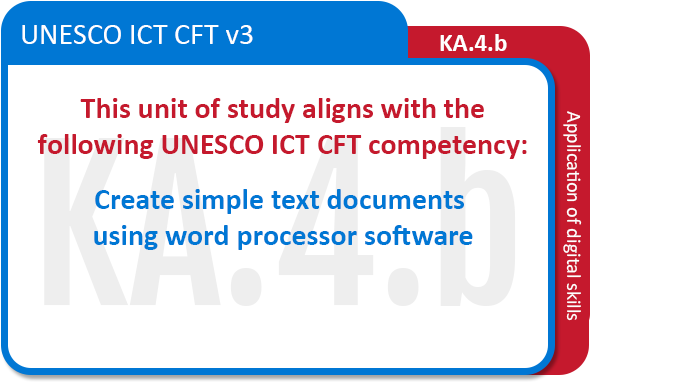Topic outline
- General
- Welcome and introduction


A word processor can enhance your role in the classroom by assisting you in creating a number of documents like lesson plans, worksheets, tests and even quizzes. These documents can be both printed or given to your students in a digital format. There are many word processors options designed for different operating systems and devices. The most popular word processing program is Microsoft Word [citation], but other options such as Google Docs, LibreOffice Writer and Apple Pages also have a following. For the purposes of this tutorial we will be taking a closer look at MS Word in this unit to find out how using this package will be beneficial to both yourself and your students.
We will brainstorm ideas on how MS Word can be used effectively in your classrooms and thereafter you will be given an assignment to complete. This assignment will test your level of skill using MS Word. So without further delay, let's get started!

By the end of this unit of study, you should be proficient in:
- Creating a new word processing document
- Saving documents
- Printing documents
- Basic formatting of documents (e.g. changing font sizes, alignment, inserting images and tables).
- Using as a teaching and learning tool

Are you a little unclear what a word processor is?
If so, watch the short video below to find out more.
- Getting started with MS Word

Getting started
There are many popular word processors around e.g. Microsoft Word and Google Docs being just two examples. For the purposes of this training session, we will focus on MS Word. However, should you not have MS Word on your computer, you will be able to use Google Docs. The online Google Docs training tutorial is available online by using the hyperlink below.
How to open MS WordOn your computer, search for an icon which looks like the graphic below. Once you click on it, MS Word will open a blank document for you.

We recommend that you experiment within this word processor - try and explore what different functionalities MS Word can offer you.
The next steps
Now that your document is open, let's first understand how MS Word is structured in terms of the toolbars at the top of your document. Review the tutorial on 'Getting started with MS Word' below.
Some additional functions
Now that you have a better idea of what some of the buttons do on the tool bar, let's learn a few extra functions:
- How do I create a new document and open an existing document?
- How do I save a document?
- How do I print a document?
- Basic formatting skills

How do I work with text?
Review the tutorials below on some of the formatting functionality which MS Word offers. It's recommended that you practice on your document whilst you are reviewing the tutorial.

- How do I add, delete, move, cut, copy and paste text?
- How do I change the size of the font? How do I change colour? How do I correct text that doesn't seem to be correctly aligned?

Sometimes when we create a document, we realise that we have used terminology or a word which is incorrect. Find out how to replace this word by a few clicks of a button as opposed to manually having to go through the whole document to find and replace it:- Using the Find and Replace functionality

We all like to make lists with either numbered or bullet points and wouldn't it be also useful to be able to insert a table into your document as well?- How do I make a list with bullet points / numbers?
- How do I insert a table into MS Word?

The final step in our formatting overview is the spell check! We all know how unprofessional it appears if there is a spelling mistake in documents, so ensure that it doesn't happen to you!- How do I check my spelling and grammar?
But there is SO much more!We have just touched the surface of the functionality that MS Word can offer us. Time permitting, review the other tutorials which GCF LearnFree has on their site.
- Ideas on how to use MS Word in class

Ideas on how to use a word processor in class
Have a look at the Digital Promise page below which will provide you with some great ideas on how to use a word processor in the classroom. Although this article is aimed at a slightly younger learner, the principles can still be applied to secondary and tertiary classrooms.
Now it's your turn!Having reviewed some of the functionality that a word processor can offer, use the forum tool below to discuss the following topics:
- What ideas do you have of how to incorporate MS Word into your classroom, both for you as a teacher and for your learners?
- How can using a word processor make your life, as a teacher, easier?
Each participant should post at least 2 comments and reply to an existing post at least once.
1
2
3
4